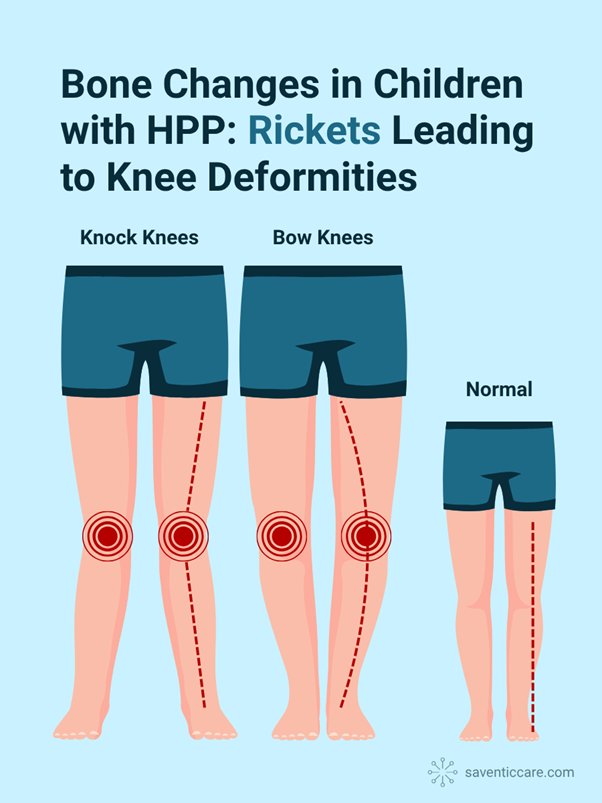Suspeita de Hipofosfatasia? Sintomas, Diagnóstico e O Que Fazer a Seguir
Se você ou seu filho apresentam fraturas frequentes, dor óssea ou perda precoce de dentes, esses sinais podem estar relacionados a uma doença rara chamada hipofosfatasia (HPP). A HPP é uma doença genética que afeta a força dos ossos e dos dentes, com sintomas que variam de problemas dentários leves a complicações ósseas graves, dependendo da idade da pessoa.

O que é Hipofosfatasia?
A hipofosfatasia é um distúrbio metabólico raro e genético, resultante de um erro congênito do metabolismo. Uma mutação no gene ALPL causa a perda de função da enzima fosfatase alcalina não específica de tecido (TNSALP). A atividade reduzida ou ausente dessa enzima prejudica a mineralização adequada dos ossos e dentes, já que a TNSALP está diretamente envolvida nesse processo.
Dependendo da idade em que os primeiros sintomas aparecem, distinguem-se várias formas da doença: perinatal, primeirai infância, infância, adulta, odontohipofosfatasia e pré-natal leve.
Quantas pessoas são afetadas?
A forma grave da doença ocorre em cerca de 1 a cada 300.000 nascimentos na Europa. Já a forma mais leve aparece em aproximadamente 1 a cada 6.000 casos.
Sintomas da Hipofosfatasia
Os sintomas dependem da forma da doença, ou seja, da idade em que se manifestam:
- A forma infantil está ssociada ao raquitismo (ossos moles e fracos que causam dor e pernas arqueadas), surgindo nos primeiros meses e anos de vida.
- A forma da infânciatem relação com baixa densidade óssea, fraturas patológicas frequentes, raquitismo, atraso no crescimento e para começar a andar, dor e inchaço nas articulações.. Além disso, pacientes jovens com esse distúrbio enfrentam o raquitismo, que afeta negativamente o crescimento e causa atraso para começar a andar. Também podem ocorrer dor e inchaço nas articulações.
- Adultos com HPP perda precoce de dentes permanentes e fraturas recorrentes nos membros inferiores (principalmente no mediopé), causando dor e fraqueza.
- Odontohipofosfatasia é associada à erupção precoce dos dentes de leite e cáries avançadas. É uma das formas mais leves da doença.

Como a Hipofosfatasia é Diagnosticada?
Uma parte essencial do diagnóstico envolve tanto exames laboratoriais quanto testes genéticos moleculares. Observa-se uma diminuição da atividade da fosfatase alcalina no plasma, acompanhada de um aumento da fosfoetanolamina (PEA) na urina, embora esses achados não sejam, por si só, indicadores definitivos para confirmar a presença de hipofosfatasia.
O diagnóstico diferencial muitas vezes é necessário para excluir outras condições, como osteogênese imperfeita ou raquitismo hipofosfatêmico. Níveis baixos de fosfatase alcalina também podem ser causados por certos medicamentos, como glicocorticoides ou intoxicação por vitamina D.
Sabe-se que quanto menor a atividade da fosfatase alcalina, mais grave é a forma da doença. Na forma perinatal da hipofosfatasia, exames de ultrassonografia também são utilizados para o diagnóstico. Radiografias podem confirmar a presença de fraturas patológicas.
Prognóstico e Perspectivas
Nos casos de hipofosfatasia adulta e odontohipofosfatasia (que envolvem principalmente questões dentárias), normalmente não há impacto na expectativa de vida. No entanto, a forma neonatal e suas complicações respiratórias associadas apresentam alta taxa de mortalidade (cerca de 50% das crianças morrem devido a essas complicações). A forma perinatal é a mais grave e quase sempre fatal, geralmente dentro de poucos dias a algumas semanas.
Como a Doença HPP Pode Ser Tratada?
Bebês e crianças com formas graves de hipofosfatasia (HPP) devem receber atendimento médico adequado para manejar os sintomas e prevenir complicações. As abordagens de tratamento podem incluir:
- Monitoramento precoce para detectar complicações neurológicas o quanto antes.
- Antiinflamatórios não esteroides (AINEs), como o naproxeno, para aliviar a dor e reduzir o inchaço doloroso da medula óssea.
- Tratamentos cirúrgicos com hastes ou pinos (fixação intramedular) para estabilizar fraturas frequentes.
- Órteses para o tornozelo em crianças com fraturas por estresse recorrentes, para oferecer suporte e reduzir o risco de lesão.
- Cuidados odontológicos contínuos para gerenciar os sintomas dentários, apoiar o desenvolvimento da fala e melhorar a nutrição.
- Medicamentos para hipercalciúria (excesso de cálcio na urina), incluindo glicocorticoides e diuréticos de alça, especialmente na forma infantil.
- Terapia com asfotase alfa:desde 2015, a Unbião Européia aprovou esta terapia de reposição enzimática para tratamento de longo prazo da hipofosfatasia com início na infância. Ela demonstrou melhorias nas articulações e apoio ao crescimento em ensaios clínicos.
Viver com Hipofosfatasia – Seu Apoio através da Saventic Care
Viver com esta condição apresenta desafios únicos, mas com o apoio correto, indivíduos podem levar vidas ativas e satisfatórias. Na Saventic Care, somos especializados em doenças raras como a Hipofosfatasia, oferecendo acesso a diagnóstico e estudos clínicos.
Você suspeita que tem Hipofosfatasia ou outra doença rara? Você pode usar nosso Check‑up de Risco gratuito para Doenças Raras. Basta preencher nosso Formulário do Paciente e nós cuidamos do resto. Receba orientações de próximos passos com o apoio de tecnologias avançadas e especialistas médicos.